How much can you see of the Andromeda Galaxy system with just a pair of binoculars? Turns out a lot!
Only tiny increases in aperture and magnification are needed to open new cosmic vistas never dreamed of by ancient skywatchers: Moon craters, Uranus and Neptune, tens of thousands of unseen stars, even asteroids. All these with nothing more than a pair of 7x50 binoculars.
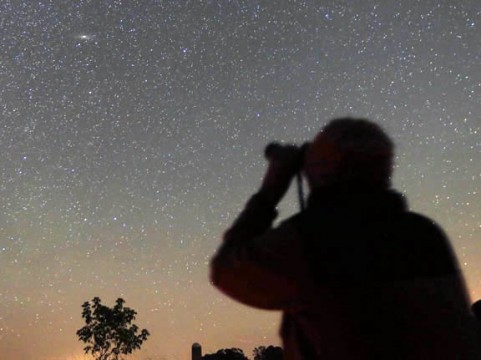
Bob King
This classic glass and similar models—8x40, 7x35 and 10x50—will serve you well on part two of our journey to the Andromeda Galaxy we began last week with our naked eyeballs. Using binoculars does take a bit of practice: first you have to focus them. Sounds simple, but many beginners struggle with the task.
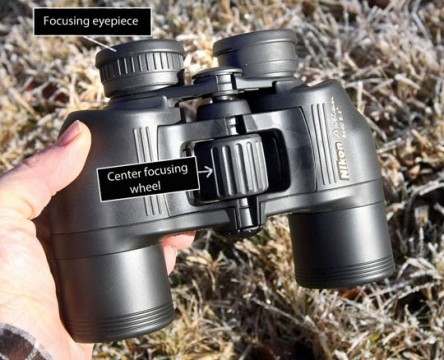
Bob King
First, set the eyepiece spacing. Grasp the barrels of the binoculars and either pull them apart or squeeze them together until the images seen through the barrels form a single, circular field of view. Now, close your right eye (not too tightly, you don't want to distort your left eyeball) while looking at an object through the left eyepiece with your left eye. Turn the center focusing knob (the one located between the two barrels) until you see a sharp image. Next, close your left eye (not too tightly) and look at the same object through the right eyepiece. Rotate the diopter adjustment ring on the right eyepiece until you get a sharp image.
Voila! Both eyes should see the scene in sharp focus. Two separate focus mechanisms are usually needed because each eye focuses a little differently for most people. From this point on, you can now focus for both eyes just by turning the center focus knob to adjust for different distances. You know you've achieved focus when stars appear as pinpoints.
Focus is critical because we'll be looking at not only the Andromeda Galaxy, but also its two galactic companions, one of which looks like an out-of-focus star. I should add that a tripod will help steady the view and therefore bring out more detail, but it's not critical for small- to modest-sized glasses. Just more comfortable!
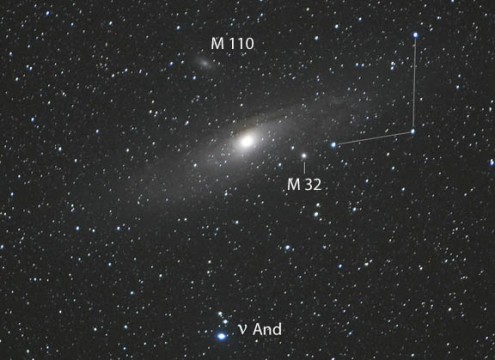
Bob King
Choose a dark, moonless night and locate the Andromeda Galaxy in the eastern sky using the method described in last week's installment. In my 8x40s and 10x50s, the galaxy leaps right out, appearing as a diffuse, much-elongated disk of soft, fuzzy light nearly 3° from end to end. With no effort at all, I can easily see the contrast between the much brighter core and the fainter disk. The galaxy's asymmetry surprised me: the southern half looks weaker and narrower compared to the puffier northern half.
Millions of old, evolved stars pack the core, called the bulge, in contrast to the more lightly-populated (and dimmer) disk. This classic dichotomy, seen in many spiral and elliptical galaxies, lies plainly exposed in Andromeda. But the dark dust lanes the define its spiral arcs remain beyond the ken of standard binoculars.
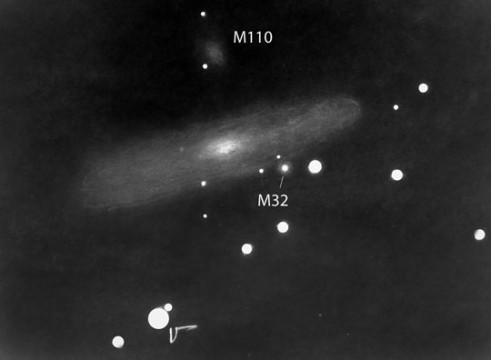
Bob King
To find Andromeda's brightest companion galaxy, use the trio of 7th-magnitude stars off the galaxy's south end. The farthest north of them points straight to a slight fainter "fuzzy star" — M32. It's an easy pick-up in 8x40s, unlike its brother M110 on the opposite side of the bright nucleus. Also known as NGC 205, this larger, less compact and fainter companion (magnitude 8.9 vs. 8.0 for M32) appears as a featureless haze at first blush. But after several minutes of study using averted vision, I finally eked out its north–south elongation. 7x50s and 10x50s work great to pull this weak piece of mist from the sky background, but nothing definite was visible in the 8x40 glasses.
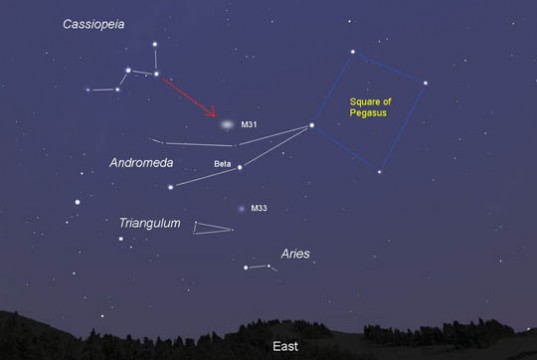
Source: Stellarium
I have a little surprise for you. Before we sign off, let's drop by another tempting target in the neighborhood, the Triangulum Galaxy located in the petite constellation Triangulum, the Triangle. You'll find it 15° southeast of M31 and well-placed for viewing around 10 o'clock p.m. in late September. Visible as the faintest of smudges with the naked eye under exceptional skies, this patchy spiral galaxy is more than two magnitudes fainter than Andromeda and a tad farther away at 2.7 million light-years.
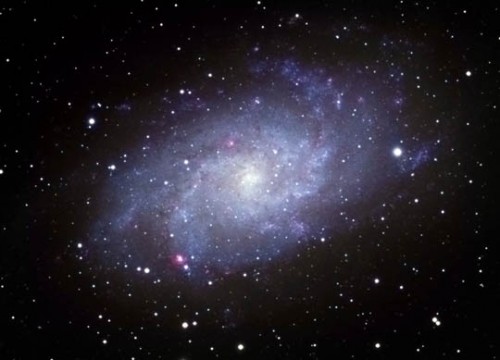
Frank Barrett / celestialwonders.com
While difficult without optical aid, an egg-shaped fuzzball greets observers equipped with a pair of 50-mm binoculars under dark skies. A single 8th-magnitude star dots the galaxy's southern rim. With effort, I can discern the slightly brighter central bulge. Unlike Andromeda, M33 has a small nucleus and far fewer stars — 40 million vs. one trillion!
While many of us have access to larger telescopes, it's fun to discover how much there is to see with a much smaller instrument. No matter what we use to examine the night sky — naked eye, binoculars, or big Dob — challenges and fresh points of view present themselves at every level.
Now that you're getting handy with the binoculars, pick up a copy of Binocular Highlights by Sky & Telescope contributing editor Gary Seronik and continue your journey into the night sky!
 6
6








Comments
Anthony Barreiro
September 16, 2015 at 6:03 pm
Thanks Bob. I can never remember where M32 and M110 are in relation to M31. Those three stars should help!
From my urban backyard, M31's core is easy to see in binoculars. Sometimes I can make out some of the disk with averted vision when the galaxy is well above the horizon. And M33 is impossible in the city, no matter what instrument you're using. But, like you say, under a dark sky it's easily visible with averted vision through binoculars -- actually easier to see in binoculars than in a telescope.
And, I find it much easier to adjust my diopter by putting a lens cap over first the right objective lens and then the left objective lens. Closing one eye at a time doesn't work for me.
You must be logged in to post a comment.
Bob KingPost Author
September 16, 2015 at 10:09 pm
Hi Anthony,
I can see how using a lens cap is a good idea. Less strain. It sounds like you're in a fairly light polluted locale based on your description of the visibility of the two galaxies. Where I live, the western-southern sky is light polluted, but the east is very good, allowing much more detail to be seen in Andromeda when it's in that direction.
You must be logged in to post a comment.
Anthony Barreiro
September 17, 2015 at 12:58 pm
I'm in San Francisco. The city seems to be going mad with LED lights. The light pollution has gotten much worse just in the past year or two.
You must be logged in to post a comment.
Anthony Barreiro
September 21, 2015 at 2:23 pm
On Saturday night I was able to find M32 through mounted 11x56 binoculars from Chabot Observatory in the Oakland hills, significantly less light polluted than my home in the middle of San Francisco. And I was able to talk visitors to the observatory through the process of seeing M31 and M32 for themselves, and understanding the size, distance, and nature of those faint wisps of light. It was a good night.
You must be logged in to post a comment.
September 16, 2015 at 8:47 pm
Thank Bob
Always nice to revisit my first Deep Sky object with binoculars.
Good Article . Thanks for reminding us all we don't need a scope for this one.
DAve
You must be logged in to post a comment.
Bob KingPost Author
September 17, 2015 at 8:53 pm
Thanks Dave - you're welcome!
You must be logged in to post a comment.
You must be logged in to post a comment.